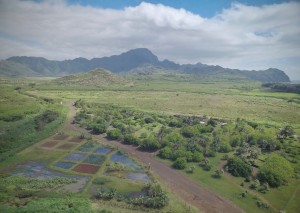Coping with Change
January 12, 2020

Much of Makauwahi Cave Reserve is vulnerable to sea level rise, flooding, drought, and storms. In the next two years we hope to establish native plants and wetland habitats at higher elevations and more sheltered locations in the old limestone quarry adjacent to the Reserve.
As Australia burns and Venice drowns, thoughts of people around the world turn to surviving change. We are no different here at Makauwahi Cave Reserve, and major coping is underway. In past newsletters, you may have read about the floods, droughts, hurricanes, tsunami, and other disasters that have struck here over the centuries.
Current threats to the Reserve, which is mostly low-lying and perpetually exposed to the ocean, include record droughts (one lasting over four years recently) and rising sea level. No use to deny it, MCR is under threat from climatic uncertainty.
Spearheaded by a major grant from the Wildlife Conservation Society’s Climate Adaptation Fund, we are embarking on an ambitious new project over the next two years in collaboration with our landowner, Grove Farm Company, and our partners in county, state, and federal agencies as well as the private sector. We plan to expand our dry forest and wetland restorations to adjacent property in the old limestone quarry site near the cave, where the new wetland and forest habitats will be at higher, more sheltered elevations. We plan to combine sophisticated erosion control structures with our proven methodology for creating wildlife habitat, restoring hydrological balance, and nurturing even some of the rarest species of native dry forest and wetland plants – and the waterbirds will love it!
Goals for the next two years include planting 4000 native trees and shrubs, including about a dozen endangered species, in the new upland site. In the three large new wetlands proposed, school groups will help us plant over 1000 native wetland plants of species known to be used by our endangered waterbirds (Hawaiian moor hen, Koloa duck, ne-ne, stilt, and coot) for food, resting, and reproducing. With careful management, we believe we can greatly expand the local populations of all five of these species — which also occur as fossils at Makauwahi Cave, showing they have thrived here for millennia.
Think what a great opportunity to educate the public this represents. At a time when the media is full of discussion about climate change, MCR is a place where hundreds of visitors per day actually can see the fossil evidence for change, in the same place where restoration efforts are implementing science-based strategies for dealing with the future through a combination of mitigation and adaptation. School groups and visitors from throughout the world will have the opportunity to not just hear, but also do something: plant trees, enhance wildlife habitat, and help monitor the results.